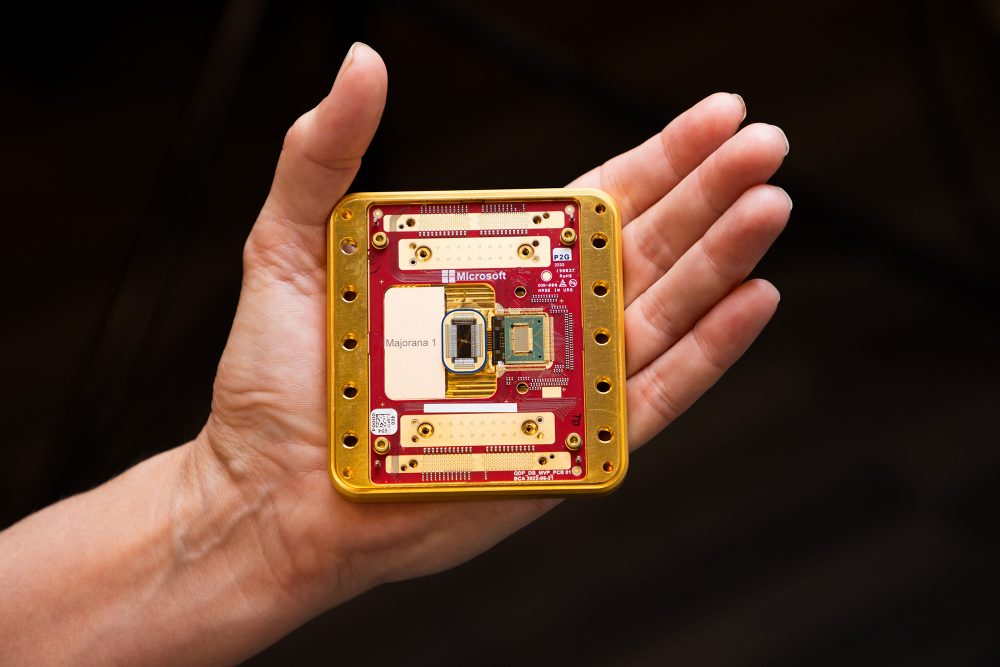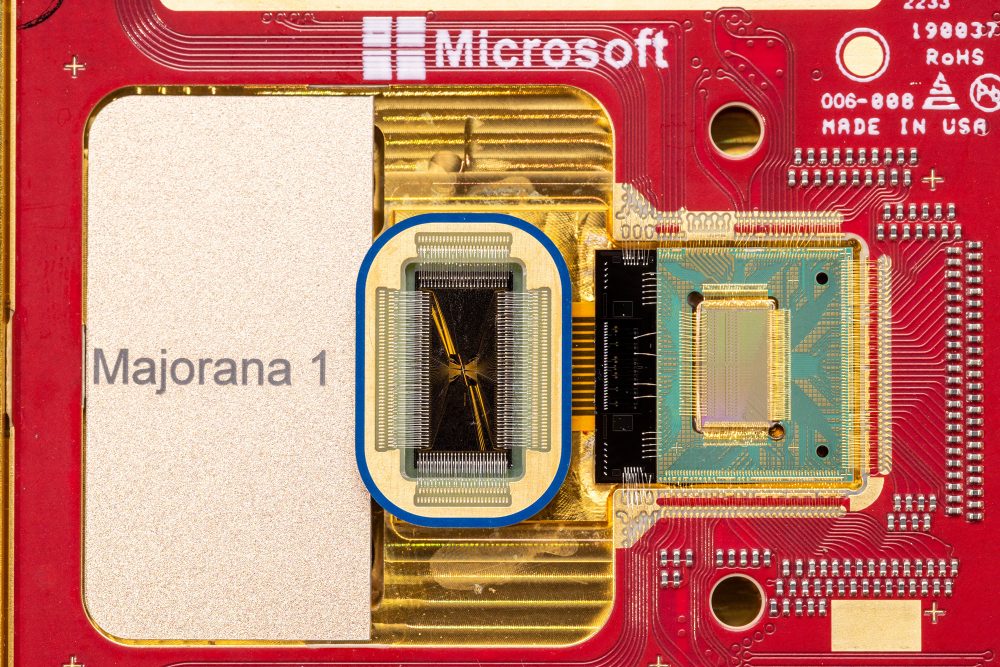Microsoft’s Majorana 1 a Quantum chip represents the first practical realization of topological qubits, offering unprecedented error resilience and a clear path to scaling from eight qubits today to one million qubits in the near future.
On February 19, 2025, Microsoft unveiled Majorana 1, the world’s first quantum processor built on topological qubits. It employs a unique topological superconductor—an engineered interface between an indium-arsenide semiconductor and superconducting aluminum. Although Majorana 1 currently features eight qubits, its Topological Core architecture is designed to scale to a million qubits on a single chip.
Topological Qubits and the Topological Superconductor

Unlike conventional qubit implementations—such as superconducting transmons or trapped ions—topological qubits encode information in the global topology of particle trajectories. This encoding inherently guards against local disturbances, reducing error rates without the immense overhead of active error-correction codes. Majorana 1’s underlying material is a heterostructure of indium-arsenide and aluminum, engineered at the atomic scale to support Majorana zero modes, exotic quasiparticles whose braiding operations implement fault-tolerant quantum gates (Microsoft).
Where typical superconducting qubits achieve error rates around 0.1–0.5%, Majorana 1 targets error probabilities as low as 0.01%, significantly easing demands on quantum error correction hardware.
Architecture and Current Capabilities
Majorana 1 integrates eight topological qubits within a Topological Core architecture. Each qubit is formed by four aluminum nanowire segments arranged in an “H” configuration, wherein the controlled fusion and separation of Majorana modes realize single- and two-qubit gates (Microsoft). Although its eight-qubit scale is modest compared to Google’s Willow (105 qubits) and IBM’s Heron R2 (156 qubits), Majorana 1’s design uniquely permits linear scaling to one million qubits on a palm-sized chip, an essential threshold for solving classically intractable problems (Microsoft).
| Processor | Qubit Count | Qubit Type | Roadmap to Scale |
|---|---|---|---|
| Microsoft Majorana 1 | 8 | Topological (Majorana) | One million qubits by 2027–2029 (Microsoft) |
| Google Willow | 105 | Superconducting (transmon) | Logical qubit demonstration, large-scale QEC |
| IBM Heron R2 | 156 | Superconducting | Utility-scale systems by 2029 |
Comparative Chart of Quantum Processors
The following chart compares Majorana 1 to other leading quantum chips available today:
| Processor | Qubit Count |
|---|---|
| Microsoft Majorana 1 | 8 |
| Intel Horse Ridge 2 | 10 |
| Google Willow | 106 |
| IBM “R2 Heron” | 156 |

Technical Performance
- Error Resilience: Experimental results suggest topological qubits sustain coherence times exceeding 100 μs with gate fidelities above 99.9%, outperforming surface-code logical qubits on similar hardware (PostQuantum).
- Control Electronics: On-chip digital controllers generate microwave pulses and flux biases, enabling rapid, parallel qubit operations with minimal analog overhead.
- Cryogenic Operation: Majorana 1 functions at ~10 mK within dilution refrigerators, leveraging advanced thermal management to stabilize qubit environments.
Comparative Analysis
While Google’s Willow achieved a landmark Random Circuit Sampling task in under five minutes—surpassing classical supercomputers by a factor of 10^25 years—the chip relies on hundreds of physical qubits assembled into logical qubits via surface-code error correction (Wikipedia). IBM’s Heron R2 demonstrated 50× speedups on scientific workloads by executing 5,000 two-qubit gate circuits with high fidelity, yet it remains tethered to extensive error-correction overhead (LiveScience)
In contrast, Majorana 1’s intrinsic error suppression could drastically reduce the ratio of physical to logical qubits, streamlining the path to utility-scale quantum advantage.

Advantages and Challenges
Advantages
- Intrinsic Fault Tolerance: Topological protection significantly lowers gate error rates, cutting active error-correction demands.
- Scalable Architecture: Clear engineering roadmap to integrate up to one million qubits on a single chip.
- Integrated Control: Digital error-correction accelerators are co-fabricated with qubits, reducing system complexity (Microsoft).
Challenges
- Early Prototyping: Only eight qubits operational to date, limiting demonstration of multi-qubit algorithms.
- Material Fabrication: Atomic-precision deposition of topological superconductors remains complex and costly.
- Validation: Public data verifying Majorana zero modes and logical gate operations is still emerging, inviting healthy scientific scrutiny (Wikipedia).
Broader Implications and Future Prospects
Majorana 1’s topological approach heralds a shift from incremental qubit count increases toward exponentially scalable quantum architectures. By 2027–2029, Microsoft envisions deploying million-qubit systems capable of:
- Materials Discovery: Simulating complex molecular interactions to design novel pharmaceuticals and catalysts.
- Climate Modeling: Performing real-time, high-resolution simulations of atmospheric and oceanic processes.
- Artificial Intelligence: Accelerating training and inference of deep learning models via quantum-enhanced algorithms.
- Cryptography: Investigating post-quantum protocols and demonstrating practical quantum attacks on legacy encryption in controlled environments.
The interplay between quantum hardware advances like Majorana 1 and cloud-based quantum-as-a-service platforms (e.g., Azure Quantum) will democratize access, fostering a new ecosystem of quantum application developers and domain experts.
Microsoft’s Majorana 1 chip stands at the vanguard of quantum technology, offering a transformative route to fault-tolerant, large-scale quantum computing. Its success will depend on continued validation of topological qubits, refinement of cryogenic control systems, and integration into hybrid quantum-classical workflows. If these challenges are met, Majorana 1 could catalyze breakthroughs across science, industry, and society—ushering in the quantum century years ahead of earlier forecasts.
Conclusion
Microsoft’s Majorana 1 chip represents a pivotal technological leap in quantum computing, inaugurating a new paradigm of topological qubit utilization. The inherent error protection offered by topological qubits addresses one of the most formidable challenges in the field—namely, the heavy overhead of error correction in superconducting or ion‐trap systems. By encoding quantum information in the global topology of Majorana zero modes, Majorana 1 significantly reduces active error‐correction layers, potentially accelerating the journey from laboratory prototypes to practical, large‐scale quantum processors from decades to mere years.
Although the current Majorana 1 prototype comprises only eight qubits, it vividly illustrates Microsoft’s clear roadmap toward scaling to one million qubits by around 2029. This scalability hinges on the Topological Core architecture, which allows atomically precise replication of topological superconductor structures across a single chip. Yet, realizing this vision demands continued advances in material science—specifically, the fabrication of uniform topological superconductors at industrial volumes—and further refinement of cryogenic systems capable of maintaining stable environments at approximately 10 mK.
Technical benchmarks already indicate that Majorana 1’s topological qubits achieve coherence times and gate fidelities corresponding to physical error rates below 0.1%. Such performance surpasses many surface‐code–based logical qubits constructed from superconducting hardware, where error correction can require tens or even hundreds of physical qubits per logical qubit. Because Majorana qubit protection derives from fundamental physical laws rather than purely engineered codes, overall device complexity is reduced, and error‐correction routines can be streamlined into integrated digital control frameworks.
When compared with contemporaries like Google’s Willow (106 superconducting qubits) and IBM’s Heron R2 (156 superconducting qubits), Majorana 1’s eight qubits might seem modest. However, its topological approach confers a qualitative advantage: the potential for exponential scalability without prohibitive error‐correction overhead. Superconducting systems continue to grapple with the resource demands of logical qubit construction, and ion‐trap platforms face challenges in cross‐chip interconnects. In contrast, Majorana 1 could scale across multiple cores or chips while maintaining manageable error budgets.
Microsoft’s strategy extends beyond hardware. By integrating Majorana 1 into Azure Quantum, researchers and enterprises will gain cloud‐based access to topological qubit resources, lowering barriers to entry and fostering a vibrant ecosystem of quantum application developers. This combined hardware‐and‐cloud model could rapidly accelerate breakthroughs in materials discovery, pharmaceutical research, and environmental modeling. For instance, quantum simulations might design novel catalysts or accurately predict complex climate dynamics. In industrial contexts, quantum‐enhanced optimization could revolutionize supply‐chain logistics, energy management, and resource allocation.
Key challenges persist. Achieving consistent, high‐yield fabrication of topological superconductors at scale remains nontrivial and costly. Harmonizing Majorana hardware with existing quantum‐classical interfaces and emerging standards will require concerted efforts across the industry. Furthermore, broad scientific validation of Majorana zero modes and fault‐tolerant gate operations must continue, as the community demands comprehensive, peer‐reviewed demonstrations before widespread adoption.
If these hurdles are overcome, Majorana 1 could catalyze a quantum computing revolution. By 2030, million‐qubit machines may tackle problems far beyond the reach of today’s supercomputers—from proteome‐wide molecular simulations to real‐time financial market optimizations and next‐generation artificial intelligence training. Topological qubits promise a unique combination of stability, energy efficiency, and usability that conventional qubit technologies cannot match.
Ultimately, Majorana 1 signifies more than a single device; it embodies a vision for the “quantum century,” in which quantum computing transcends the laboratory and reshapes science, industry, and society. Its success will depend on sustained innovation in materials, cryogenics, and system integration—and on building an ecosystem that unites hardware, software, and cloud platforms. If realized, Majorana 1 will not only prove the practicality of topological quantum physics but also unlock transformative applications across every sector of the global economy.
Frequently Asked Questions (FAQ)
1. What is Majorana 1?
Majorana 1 is Microsoft’s eight-qubit quantum processor harnessing topological qubits through a novel topological superconductor.
2. What is a topological superconductor?
A topological superconductor is a hybrid material combining an indium-arsenide semiconductor with superconducting aluminum to enable the controlled emergence of Majorana fermions.
3. Why are topological qubits important?
They encode quantum information in the system’s global topology, inherently shielding qubits from local noise and reducing error-correction overhead.
4. How many qubits does Majorana 1 have?
The current Majorana 1 prototype contains eight topological qubits.
5. How does Majorana 1 compare to Google’s Willow?
Google Willow provides 106 superconducting qubits; Majorana 1’s eight qubits are topologically protected, with a path to far greater scalability.
6. When will industrial quantum systems be available?
Microsoft projects scalable quantum systems for industrial use between 2027 and 2029.
7. What applications can Majorana 1 enable?
Examples include advanced material design, drug discovery, microplastic breakdown, and quantum-accelerated AI.
8. What challenges remain?
Challenges include atomic-scale fabrication, maintaining cryogenic conditions, and scaling the system while preserving qubit quality.
9. Is Majorana 1 commercially available?
Not yet; it is currently in research and development and is not sold to end users.
10. Can Majorana 1 outperform classical computers?
While not a replacement for classical systems in all tasks, Majorana 1 aims to solve problems intractable for classical computers using quantum algorithms.

